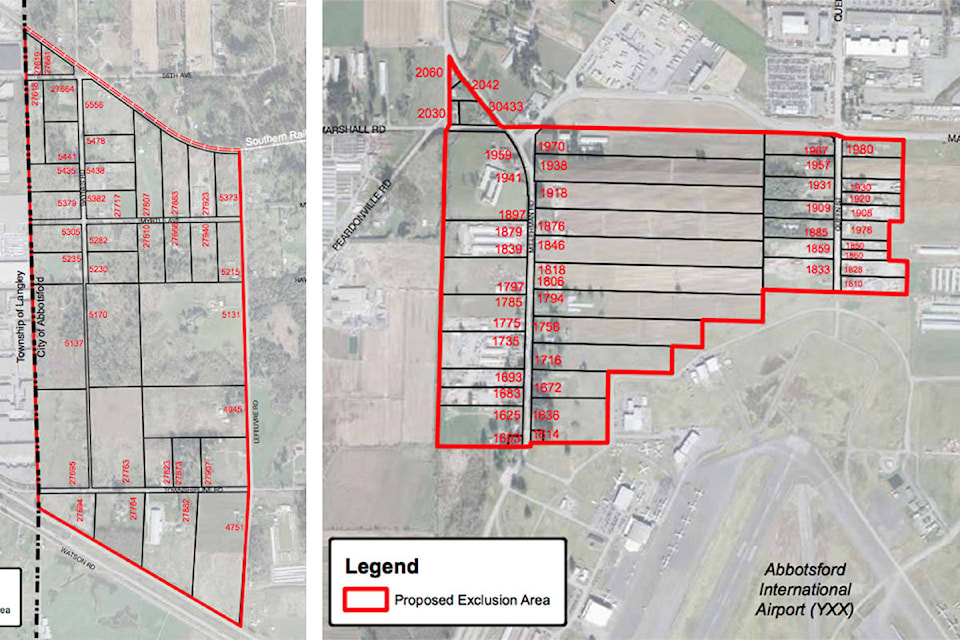The City of Abbotsford won’t ask the Agricultural Land Commission to reconsider its request to remove farmland from the ALR in order to provide more room for industry. But Mayor Henry Braun warned that it’s unlikely that residents will have seen the last of the controversial proposal.
Council recently agreed with staff’s recommendation that the city not seek to have the matter re-opened before a one-year deadline to seek reconsideration closes later this month. Staff deemed that there was no new evidence that could have gotten the ALC to overturn their rejection of the city’s application. Rather, the city would be better off submitting, at some point in the future, a new application that would “be informed by the priorities of the day for the city and the province, staff wrote in their report. Coun. Patricia Ross, who had voted against the original application, also voted against Monday’s motion.
“I am supportive of keeping this open and this will come back, I predict, at some point, if not for this council then a future council to deal with,” Braun said.
The NDP government has said that the protection of the Agricultural Land Reserve is a priority, and the ALC said last year that the lands in question could be farmed and should remain in the ALR. But the province continues to review its agricultural policies, along with those governing land in the ALR.
RELATED: No industrial development on Abbotsford farmland, ALC tells city
RELATED: ALR decision aftermath: Bradner residents consider election action; mayor disappointed
The city had asked in 2017 for the removal of around 200 hectares of land from the ALR to accommodate future industrial growth. The land was located in two blocks – one north of Abbotsford International Airport, the other in Bradner, north of Highway 1 and adjacent to the Township of Langley and another industrial park. The city had argued that the supply of industrial lands in Abbotsford and across the region was quickly diminishing and that those lands that did remain were mostly incapable of serving large regional-sized industrial businesses.
But many people disagreed and the issue was the most contentious that came before council during its last four-year term. Dozens spoke in opposition at a 2017 public hearing prior to the application’s submission. Bradner residents worried that the removal of land on the western border of Abbotsford would dramatically change their neighbourhood. Many others spoke about the need to protect farmland and green space in Abbotsford.
Both blocks of land had been the subject of previous failed ALR exclusion requests.
Braun said he has been asked why the lands in question continue to be targeted for exclusion. He noted the lands have been included in the Fraser Valley Regional District’s growth strategy since 2004, and said there simply aren’t many other areas where industrial development is possible.
“We need to keep our options open,” he said. “There are no industrial lands that we can look at that are not in the ALR.”
Farming might be possible on those lands targeted for exclusion, but he said the inputs required to make it so are only increasing as the region’s climate changes.
And if the province is serious about protecting the very best agricultural land in the province – such as that on the Matsqui and Sumas prairies – he said barring the building of large homes while permitting processing facilities with concrete foundations doesn’t make much sense.
“We’re taking, in some places, some of the best land in Sumas/Matsqui prairie out of production in favour of processing plants.”
He added that the region’s changing climate may also be making the farming of those marginal plots more difficult.
“We need more industrial lands and agriculture itself is changing. The farming community needs access to lands for processing,” he said. “I happen to think that processing plants on prime agricultural lands is the wrong place to be. There should be some kind of agri-industrial land available to put those plants on.”
MORE TOP STORIES: ‘Alarm bells’ raised by footage allegedly from Abbotsford pig farm, SPCA says
@ty_olsen
tolsen@abbynews.com
Like us on Facebook and follow us on Twitter.
